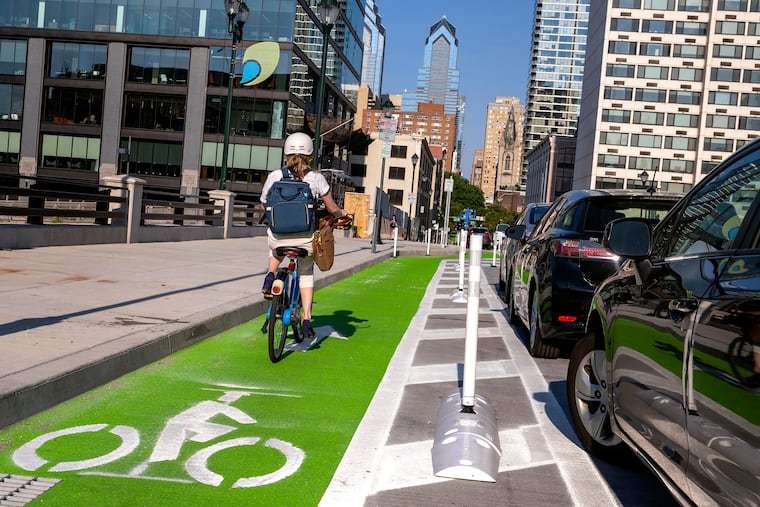An outdated parking rule in Pa. law threatens the safest kind of bike lanes
Pennsylvania law on street parking is decades old. It limits protected bike lanes.

Bike lanes separated from traffic by parked vehicles on several busy state routes in Philadelphia have drawn flocks of cyclists, slowed cars, and reduced accidents, a study of the lanes shows.
They also could be among the last of their kind in the city unless the state Senate acts to clarify the definition of a curb.
Parking-separated bike lanes have historically been barred on state-owned roadways because Pennsylvania law requires parked vehicles to be within 12 inches of the curb, or the edge of the pavement.
The lanes, also referred to as “parking-protected,” are dedicated tracks for cyclists with a row of parked vehicles to shield them from being hit by cars and trucks. A marked 5-foot-wide lane abuts the curb and drivers park on the other side of a safety buffer — putting them up to 8 feet from the curb, a violation of the Pennsylvania law.
This arrangement is considered among the safest arrangements for bicycles and is widely used in the United States and Europe.
Legislation to allow cars to park within a foot of the buffer of a parking-protected bike lane has not moved in the state Senate, though the House unanimously passed it in March of last year. The measure enjoys support from PennDot, safety advocates, and local governments around the state that want the option as part of a strategy to make streets safer for all users.
“We are hopeful that the Senate will carry HB140 over the finish line,” said Sarah Clark Stuart, executive director of the Bicycle Coalition of Greater Philadelphia. “The entire commonwealth will benefit from adding this type of safety measure to the traffic engineering toolbox.”
Help us make our Business coverage better for you: We may change parts of the Business section and need your help. Complete our anonymous survey and you can enter to win a $75 American Express gift card.
Philadelphia has parking-separated bike lanes on sections of 10 state routes, including Market Street, JFK Boulevard, and the Chestnut Street Bridge. They have operated since 2018 as pilot projects under agreements with PennDot.
If the legislature doesn’t change the law, existing pilots would continue, but it could be difficult to add more without authorization for permanent parking-separated bike lanes, PennDot spokesperson Alexis Campbell said.
“The data collected in these pilots is incredibly useful and will help us shape projects moving forward,” Campbell said. “We will continue to work with the city on a case-by-case basis if there are additional pilot locations that can inform the future use of parking-protected bike lanes.”
PennDot backs the legislation to “provide more flexibility in how we can accommodate all roadway users,” she said.
A transportation consultant’s traffic study conducted last year found benefits to the lanes on Market Street and JFK Boulevard.
Kittleson & Associates found accidents decreased by nearly 20%, though fewer people were driving during the pandemic, which may have been a factor. Average car speeds declined 6%, but the city did not see evidence of more congestion. The number of bikes using the routes jumped 96%, a possible result of a perception that they were safer for cyclists.
So far, the bike-lane bill has not drawn any concerted opposition. The Senate Transportation Committee held a hearing on the House bill in April, but the panel’s chairman, Sen. Wayne Langerholc Jr. (R., Cambria), has not scheduled a vote to send it to the floor for consideration.
The Senate reconvenes Monday and has 14 voting sessions scheduled before June 30, followed by more than two months of summer recess. Three voting days are scheduled for September, six in October, and one in November.
The legislature’s two-year session ends Dec. 31; any laws not passed by then must be reintroduced.
Although the city can build parking-protected bike lanes on its own streets, many of the most dangerous roads are state routes with high traffic volumes and average speeds. About 360 miles of Philadelphia’s 2,575 miles of roads are owned by PennDot.
Changes in parking or driving lanes on local streets need City Council approval.
In Philadelphia, accommodating bicycle travel has sometimes been politically fraught as critics of bike lanes point to a crimp in space for vehicle parking and business loading zones, or slower traffic flow.
A pair of senators during April’s hearing said parking-protected bike lanes could cause problems in some cases.
Sen. Mario Scavello (R., Monroe) said many Main Street businesses in smaller towns take deliveries through the front door. He was concerned that could lead to trucks impinging on a bike lane or “stacking” in traffic lanes to unload.
“I’m for the concept … [but] I think that small businesses will have issues,” Scavello said.
And Sen. Camera Bartolotta (R., Beaver) raised the issues of electric bicycles and e-scooters using bike lanes, possibly endangering people with disabilities who will have to cross them after exiting parked vehicles.
“They’re not used to looking for an oncoming e-scooter that’s going 25 mph, that might mow them down as they’re getting to the sidewalk,” she said, though e-scooters are not legal in the state.
Advocates say that loading zones can be incorporated into the design of streets with parking-separated bike lanes and that they would not be appropriate in all areas. PennDot would publish engineering standards and local planners would decide whether and where to build the lanes.
“I believe it is important to acknowledge that the reason they are currently illegal has nothing to do with them and their function within the public right of way,” said Nicholas Ross, chief traffic engineer in Pittsburgh’s transportation department. It’s a matter of “obsolete” legal language that has an unintended consequence, he said.